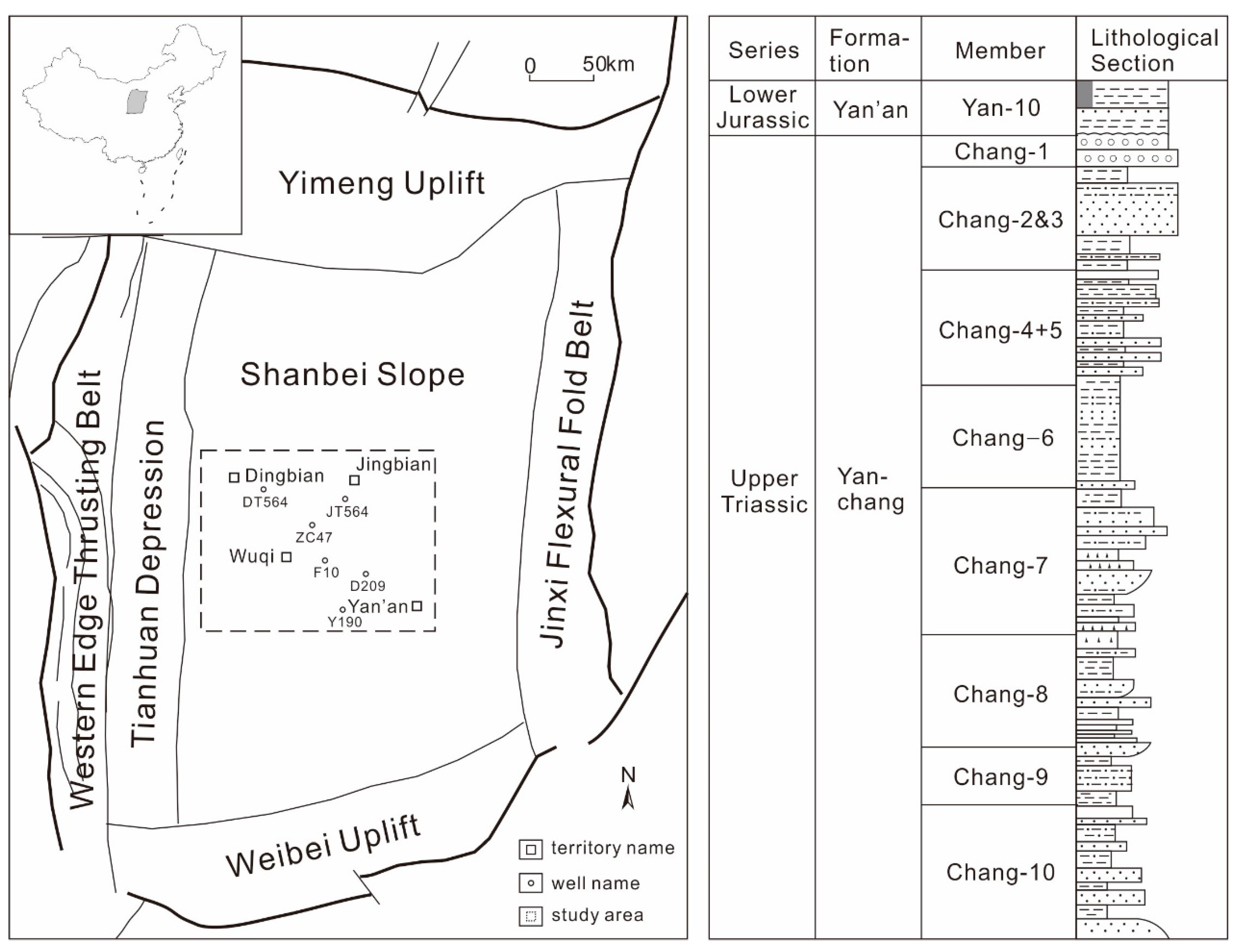Differential Diagenesis and Hydrocarbon Charge of the Tight-Sandstone Reservoir: A Case Study from Low-Permeable Sandstone Reservoirs in the Ninth Member of the Upper Triassic Yanchang Formation, Ordos Basin, China
Abstract
1. Introduction
2. Geological Setting
3. Samples and Methods
4. Results
4.1. Macro-Scale Observations and Statistical Characterization
4.2. Sandstone Petrology
4.3. Diagenesis of the Oil-Bearing Sandstone
4.3.1. Cementation
4.3.2. Fluorescence of the Pore Asphalt and Hydrocarbon-Bearing Fluid Inclusions
4.4. Diagenesis of the Oil-Free Sandstone
4.4.1. Mechanically Compacted Sandstone
4.4.2. Calcite-Cemented Sandstone
4.4.3. Water-Bearing Sandstone
4.5. Petrography and Homogenization Temperatures of the Fluid Inclusions
5. Discussion
5.1. Theoretical Basis for Dividing the Diagenesis by the Hydrocarbon Charging Events
5.2. The Process of Diagenesis and the Hydrocarbon Charge According to the Basin Uplift and Subsidence Events
6. Conclusions
Author Contributions
Funding
Data Availability Statement
Conflicts of Interest
References
- Pettijohn, F.J.; Potter, P.E.; Siever, R. Sand and Sandstone; Springer Science & Business Media: New York, NY, USA, 2012. [Google Scholar]
- Fitch, P.J.; Lovell, M.A.; Davies, S.J.; Pritchard, T.; Harvey, P.K. An integrated and quantitative approach to petrophysical heterogeneity. Mar. Pet. Geol. 2015, 63, 82–96. [Google Scholar] [CrossRef]
- Hussain, A.; Butt, M.N.; Olariu, C.; Malik, M.H.; Koeshidayatullah, A.; Amao, A.; Al-Ramadan, K. Unravelling reservoir quality heterogeneity in mixed siliciclastic-carbonate deposits: An example from Miocene Red Sea rift, NW Saudi Arabia. Mar. Pet. Geol. 2022, 145, 105850. [Google Scholar] [CrossRef]
- Hussain, A.; Bello, A.; Butt, M.N.; Malik, M.H.; Koeshidayatullah, A.; Amao, A.; Olariu, C.; Al-Ramadan, K. Diagenetic variability in Tertiary, syn-rift mixed siliciclastic-carbonate depositional system (Lower Musayr Formation), Red Sea, Saudi Arabia. Sediment. Geol. 2024, 470, 106699. [Google Scholar] [CrossRef]
- Weber, K.J. How heterogeneity affects oil recovery. In Reservoir Characterization; Lake, L.W., Carroll, H.B., Jr., Eds.; Academic Press: New York, NY, USA, 1986; pp. 487–544. [Google Scholar]
- Davis, J.M.; Roy, N.D.; Mozley, P.Z.; Hall, J.S. The effect of carbonate cementation on permeability heterogeneity in fluvial aquifers: An outcrop analog study. Sediment. Geol. 2006, 184, 267–280. [Google Scholar] [CrossRef]
- Barton, M.D.; Tyler, N.; Angle, E.S. Facies architecture and permeability structure of valley-fill sandstone bodies, Cretaceous Ferron Sandstone, Utah. In Regional to Wellbore Analog for Fluvial-Deltaic Reservoir Modeling: The Ferron Sandstone of Utah; Chidsey, T.C.J., Adams, R.D., Morris, T.H., Eds.; AAPG Studies in Geology: Tulsa, OK, USA, 2004; Volume 50, pp. 383–403. [Google Scholar]
- Morad, S.; Al-Ramadan, K.; Ketzer, J.M.; De Ros, L.F. The impact of diagenesis on the heterogeneity of sandstone reservoirs: A review of the role of depositional facies and sequence stratigraphy. AAPG Bull. 2010, 94, 1267–1309. [Google Scholar] [CrossRef]
- Dutton, S.P. Calcite cement in Permian deep-water sandstones, Delaware Basin, west Texas: Origin, distribution, and effect on reservoir properties. AAPG Bull. 2008, 92, 765–787. [Google Scholar] [CrossRef]
- Qiao, J.C.; Zeng, J.H.; Jiang, S.; Wang, Y.N. Impacts of sedimentology and diagenesis on pore structure and reservoir quality in tight oil sandstone reservoirs: Implications for macroscopic and microscopic heterogeneities. Mar. Pet. Geol. 2020, 111, 279–300. [Google Scholar] [CrossRef]
- Mikes, D.; Barzandji, O.H.M.; Bruining, J.; Geel, C.R. Upscaling of small-scale heterogeneities to flow units for reservoir modeling. Mar. Pet. Geol. 2006, 23, 931–942. [Google Scholar] [CrossRef]
- Zhang, L.Q.; Li, Z.X.; Luo, X.R. Sedimentary-diagenetic characteristics and heterogeneity models of sandstone reservoirs: An example of silurian kalpintage formation, northwestern tarim basin, China. Mar. Pet. Geol. 2020, 118, 104440. [Google Scholar] [CrossRef]
- Hamilton, D.S. Approaches to identifying reservoir heterogeneity in barrier/strandplain reservoirs and the opportunities for increased oil recovery: An example from the prolific oil-producing Jackson-Yegua trend, south Texas. Mar. Pet. Geol. 1995, 12, 273–290. [Google Scholar] [CrossRef]
- Mikes, D.; Bruining, J. Standard flow cells to incorporate small-scale heterogeneity (crossbedding) in a reservoir model. Mar. Pet. Geol. 2006, 23, 979–993. [Google Scholar] [CrossRef]
- Tavakoli, V.; Rahimpour-Bonab, H.; Esrafili-Dizaji, B. Diagenetic controlled reservoir quality of South Pars gas field, an integrated approach. Comptes Rendus Geosci. 2011, 343, 55–71. [Google Scholar] [CrossRef]
- McBride, E.F.; Milliken, K.L.; Cavazza, W.; Cibin, U.; Fontana, D.; Picard, M.D.; Zuffa, G. Heterogeneous distribution of calcite cement at the outcrop scale in Tertiary sandstones, northern Apennines, Italy. AAPG Bull. 1996, 79, 1044–1063. [Google Scholar]
- Lima, R.D.; De Ros, L.F. The role of depositional setting and diagenesis on the reservoir quality of Devonian sandstones from the Solimões Basin, Brazilian Amazonia. Mar. Pet. Geol. 2002, 19, 1047–1071. [Google Scholar] [CrossRef]
- Erik, M.T.; Jens, J.; Bjørlykke, K. Diagenetic controls on reservoir quality in Middle to Upper Jurassic sandstones in the South Viking Graben, North Sea. AAPG Bull. 2011, 95, 1937–1958. [Google Scholar]
- Hawkins, P.J. Relationship between diagenesis, porosity reduction and oil replacement in Late Carboniferous sandstone reservoirs, Bothamsall oil field, E Midlands. J. Geol. Soc. 1978, 135, 7–24. [Google Scholar] [CrossRef]
- Luo, X.R.; Lei, Y.H.; Zhang, L.K.; Chen, R.Y.; Chen, Z.K.; Xu, J.H.; Zhao, J. Characterization of carrier formation for hydrocarbon migration: Concepts and approaches. Acta Pet. Sin. 2012, 33, 428–436. [Google Scholar]
- Zhang, L.P.; Bai, G.P.; Luo, X.R.; Ma, X.H.; Chen, M.J.; Wu, M.H.; Yang, W.X. Diagenetic history of tight sandstones and gas entrapment in the Yulin Gas Field in the central area of the Ordos Basin, China. Mar. Pet. Geol. 2009, 26, 947–989. [Google Scholar] [CrossRef]
- Hu, C.Z.; Zhang, L.K.; Luo, X.R.; Zhao, H.; Yang, B.; Cao, B.F.; Lei, Y.H.; Cheng, M.; Li, C. Diagenesis and porosity evolution of the low-porosity and low-permeability sandstones: Evidence from the low Jurassic Sangonghe Formation in Moxizhuang Area, Central Junggar Basin. Nat. Gas Geosci. 2015, 26, 2254–2266. [Google Scholar]
- Nedkvitne, T.; Bjørlykke, K. Secondary porosity in the Brent Group (Middle Jurassic), Hildra field, North Sea: Implication for predicting lateral continuity of sandstones. J. Sediment. Petrol. 1992, 62, 23–34. [Google Scholar]
- Worden, R.H.; Morad, S. Quartz cementation in oil field sandstones: A review of the key controversies. In Quartz Cementation in Sandstones; Worden, R.H., Morad, S., Eds.; Wiley: New York, NY, USA, 2000; Volume 29, pp. 1–20. [Google Scholar]
- Luo, X.R.; Zhang, L.P.; Yang, H.; Fu, J.H.; Yu, J.; Yang, Y.; Wu, M.H. Oil accumulation process in the low-permeability Chang 81 member of Longdong Area, Ordos Basin. Oil Gas Geol. 2010, 31, 770–778. [Google Scholar]
- Luo, X.R.; Hu, C.Z.; Xiao, Z.Y.; Zhao, J.; Zhang, B.S.; Yang, W.; Zhao, H.; Zhao, F.Y.; Lei, Y.H.; Zhang, L.K. Effects of carrier bed heterogeneity on hydrocarbon migration. Mar. Pet. Geol. 2015, 68, 120–131. [Google Scholar] [CrossRef]
- Ma, Y.Q.; Zhang, C.; Lu, Y.C.; Kong, X.Y.; Guo, Y.; Dong, Y.X.; Chen, L.; Qi, R.; Xing, F.C. Characteristics, main controlling factors and densification mechanisms of unconventional tight reservoirs in triassic Yanchang formation in southern ordos basin, China. Pet. Sci. 2024, 21, 3884–3898. [Google Scholar] [CrossRef]
- Zhou, J.G.; Yao, G.S.; Deng, H.Y.; Xin, Y.G.; Hu, H.; Zheng, X.P.; Gong, Q.S. Exploration potential of Chang 9 member, Yanchang Formation, Ordos Basin. Pet. Explor. Dev. 2008, 35, 289–293. [Google Scholar] [CrossRef]
- Fu, J.H.; Li, S.X.; Liu, X.Y.; Deng, X.Q. Sedimentary facies and its evolution of the Chang 9 interval of Upper Triassic Yanchang Formation in Ordos Basin. J. Palaeogeogr. 2012, 14, 269–284. [Google Scholar]
- Folk, R.L.; Andrews, P.B.; Lewis, D.W. Detrital sedimentary rock classification and nomenclature for use in New Zealand. J. Geol. Geophys. 1970, 13, 937–968. [Google Scholar] [CrossRef]
- Longman, M.W. Carbonate diagenetic textures from near surface diagenetic environments. AAPG Bull. 1980, 64, 461–487. [Google Scholar]
- Bjørlykke, K.; Jahren, J. Open or closed geochemical systems during diagenesis in sedimentary basins: Constraints on mass transfer during diagenesis and the prediction of porosity in sandstone and carbonate reservoirs. AAPG Bull. 2012, 96, 2193–2214. [Google Scholar] [CrossRef]
- Moraes, M.A.S.; Surdam, R.C. Diagenetic heterogeneity and reservoir quality: Fluvial, deltaic, and turbiditic sandstone reservoirs, Potiguar and Recôncavo rift basins, Brazil. AAPG Bull. 1993, 77, 1142–1158. [Google Scholar]
- Hindle, A.D. Petroleum migration pathways and charge concentration: A three dimensional model. AAPG Bull. 1997, 81, 1451–1481. [Google Scholar]
- Liao, Z.W. Geochemical Studies on Asphaltenes and Their Possible Applications in Petroleum Exploration and Production. Ph.D. Thesis, Guangzhou Institute of Geochemistry, Guangzhou, China, 2001; pp. 1–85.
- Parnell, J.; Middleton, D.; Chen, H.H.; Hall, D. The use of integrated fluid inclusion studies in constraining oil charge history and reservoir compartmentation: Examples from the Jeanne d’Arc Basin, offshore Newfoundland. Mar. Pet. Geol. 2001, 18, 535–549. [Google Scholar] [CrossRef]
- Jia, W.L.; Peng, P.A. Asphaltene structure in reservoir affected by discharge of secondary condensate oil: Laboratory simulation. Pet. Explor. Dev. 2003, 30, 112–116. [Google Scholar]
- Walderhaug, O.; Aase, N.E. The effect of hydrocarbon on quartz cementation: Diangenesis in the Upper Jurassic sandstones of the Miller Field, North Sea, revisited. Pet. Geosci. 2005, 11, 215–223. [Google Scholar]
- Ren, Z.L.; Zhang, S.; Gao, S.L.; Cui, J.P.; Xiao, Y.Y.; Xiao, H. Tectonic thermal evolution history and its impaction on reservoir formation of Ordos Basin. Sci. China Earth Sci. 2007, 50, 27–38. [Google Scholar] [CrossRef]
- Qi, K.; Ren, Z.L.; Cui, J.P.; Yu, Q.; Cao, Z.P.; Yang, P.; Deng, Y.R.; Zhang, M.T. The Meso-Cenozoic tectonic thermal evolution of the Qishan-Linyou Areas in Weibei Uplift of Ordos Basin and its response in geology: Evidence from Fission-track analysis. Acta Geol. Sin. 2017, 91, 151–162. [Google Scholar]
- Pittman, E.D.; Larese, R.E. Compaction of lithic sands: Experimental results and applications. AAPG Bull. 1991, 75, 1279–1299. [Google Scholar]
- Luo, J.L.; Liu, X.H.; Lin, T.; Zhang, S.; Li, B. Impact of diagenesis and hydrocarbon emplacement on sandstone reservoir quality of the Yanchang formation (Upper Triassic) in the Ordos Basin. Acta Geol. Sin. 2006, 80, 664–673. [Google Scholar]
- Zhang, C. Research on Microscopic Pore Structure and Porosity Evolution in Low-Permeability Sandstone Reservoirs. Ph.D. Thesis, Northwest University, Xi’an, China, 2013; pp. 1–166. [Google Scholar]
- Mousavi, M.A.; Bryant, S.L. Geometric models of porosity reduction by ductile grain compaction and cementation. AAPG Bull. 2013, 97, 2129–2148. [Google Scholar] [CrossRef]
- Wang, Q.; Zhuo, X.Z.; Chen, G.J.; Li, X.Y. Characteristics of carbon and oxygen isotopic compositions of carbonate cements in Triassic Yanchang sandstone in Ordos Basin. Nat. Gas Ind. 2007, 27, 28–32. [Google Scholar]
- Dutton, S.P.; White, C.D.; Willis, B.J.; Novakovic, D. Calcite cement distribution and its effect on fluid flow in a deltaic sandstone, Frontier Formation, Wyoming. AAPG Bull. 2002, 86, 2007–2021. [Google Scholar]
- Pan, G.F.; Liu, Z.; Zhao, S.; Hu, Z.Q.; Hu, X.D. Quantitative simulation of sandstone porosity evolution: A case from Yanchang Formation of the Zhenjing area, Ordos Basin. Acta Pet. Sin. 2011, 31, 770–778. [Google Scholar]
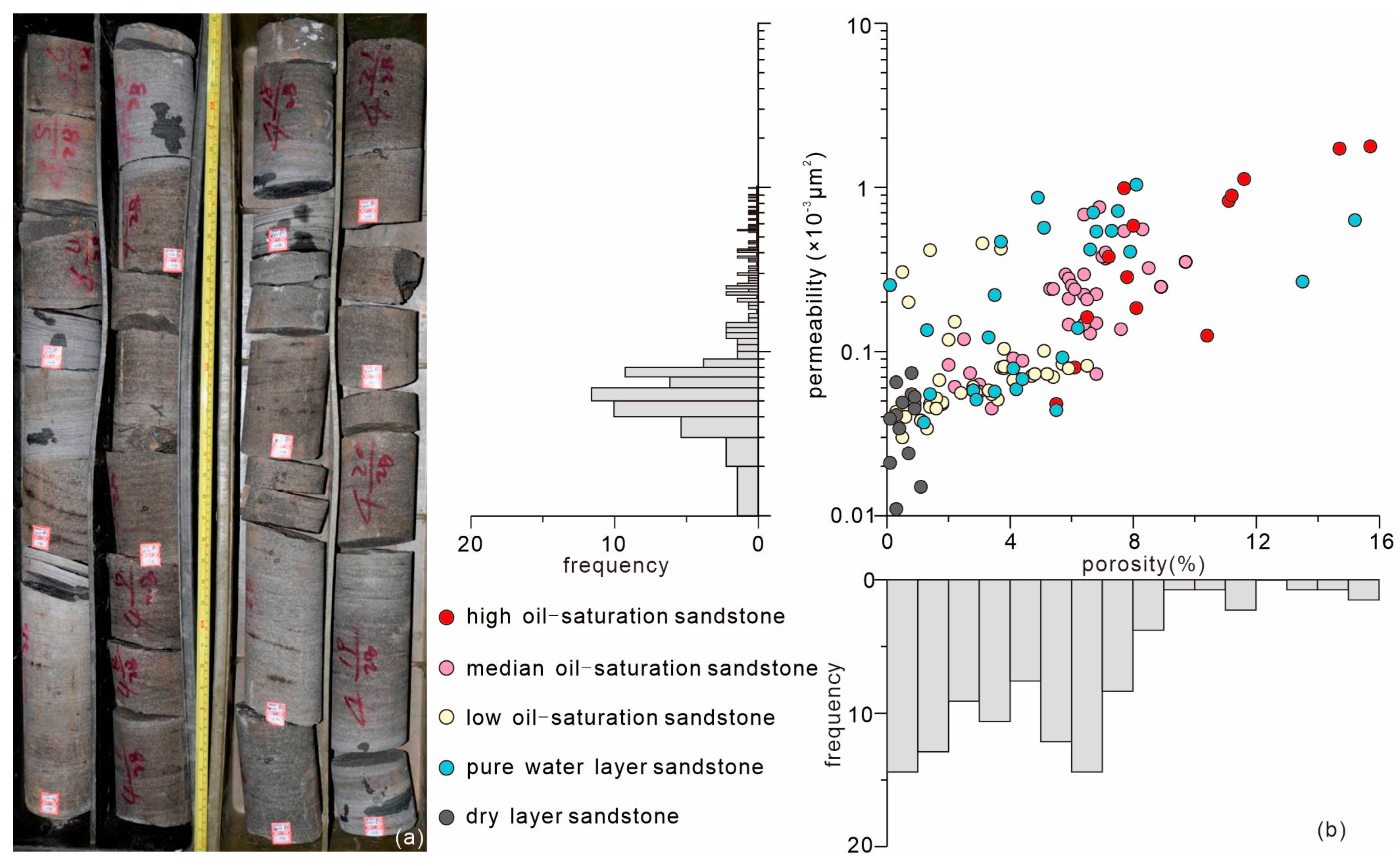
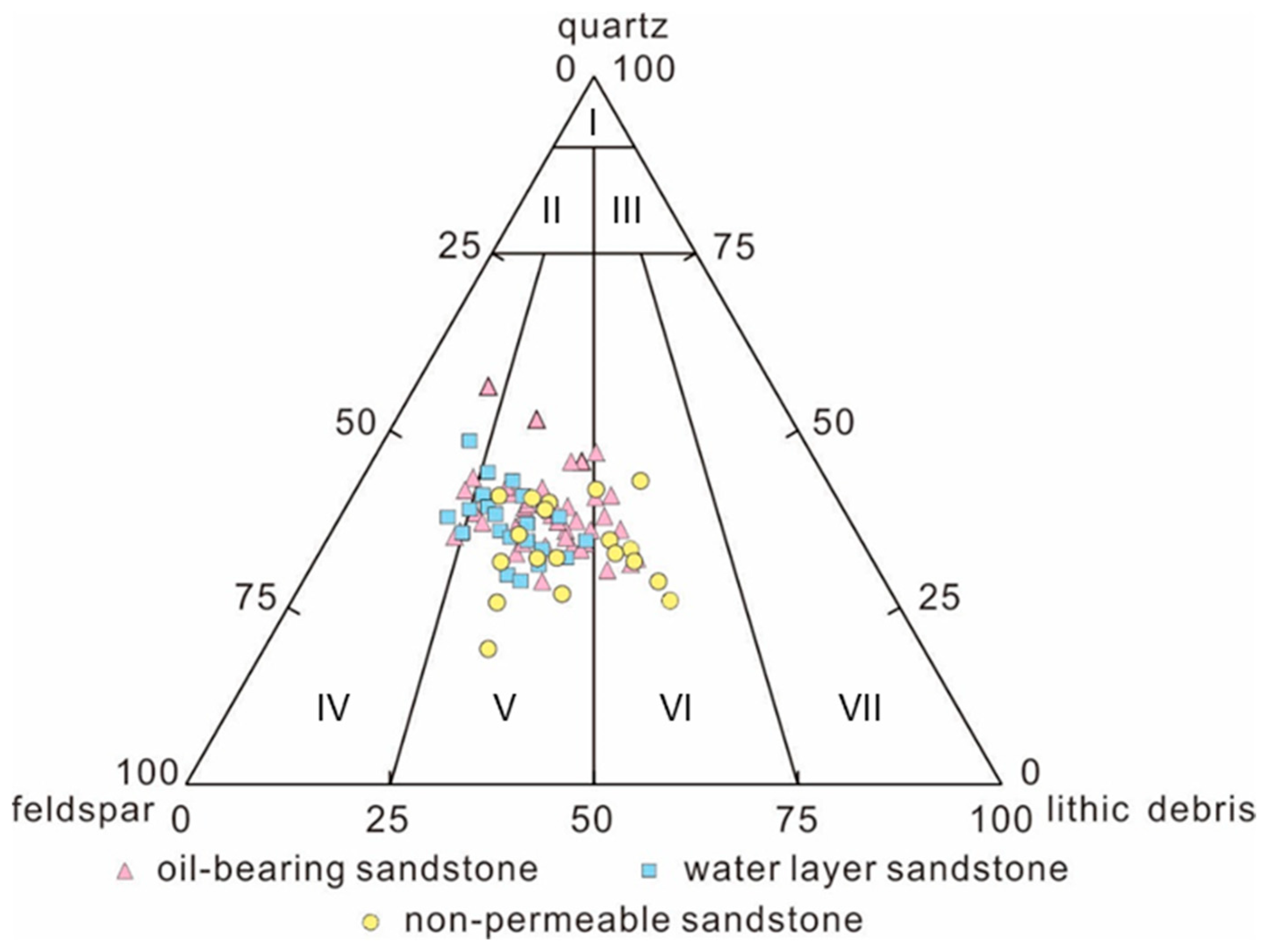
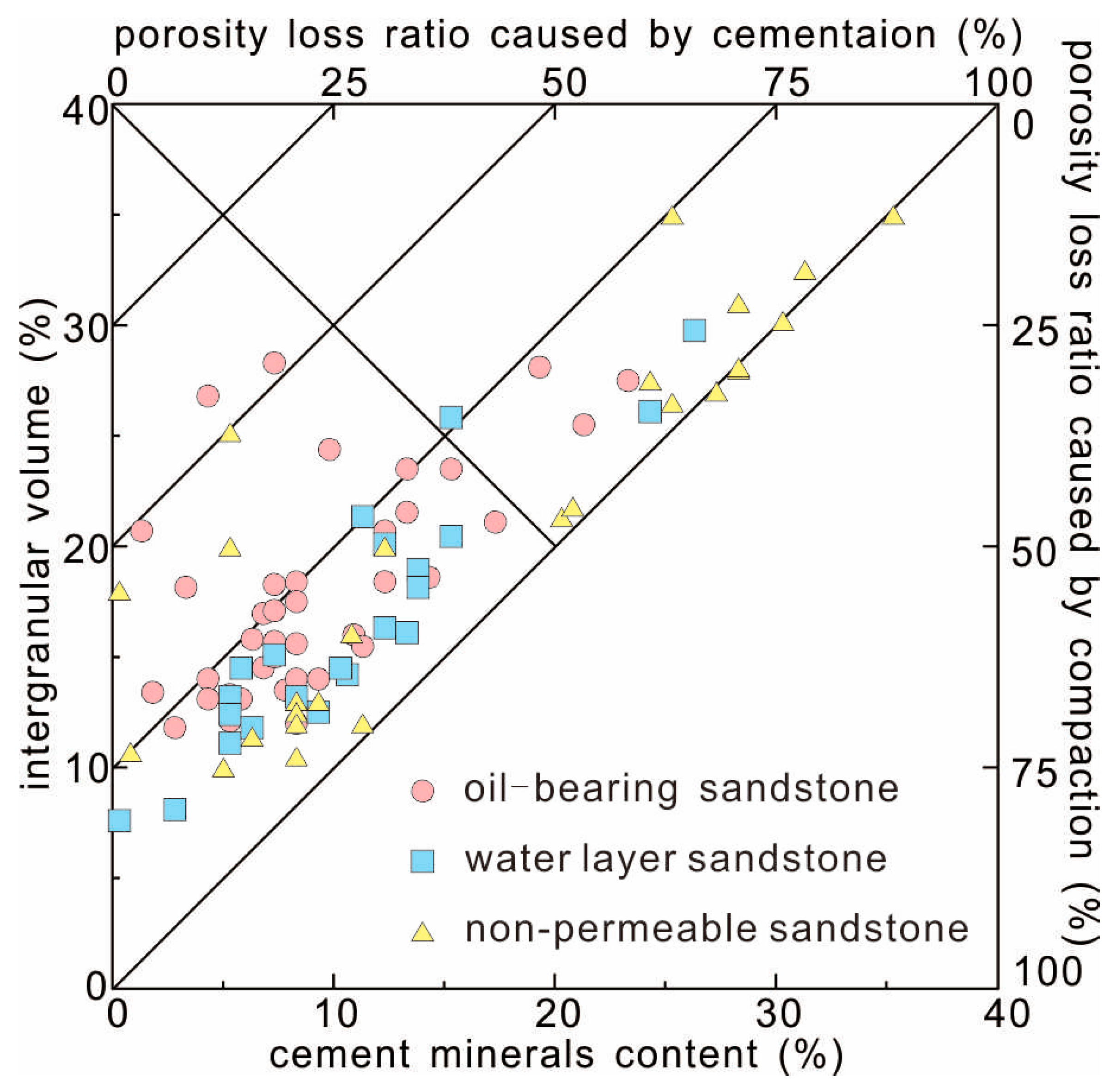
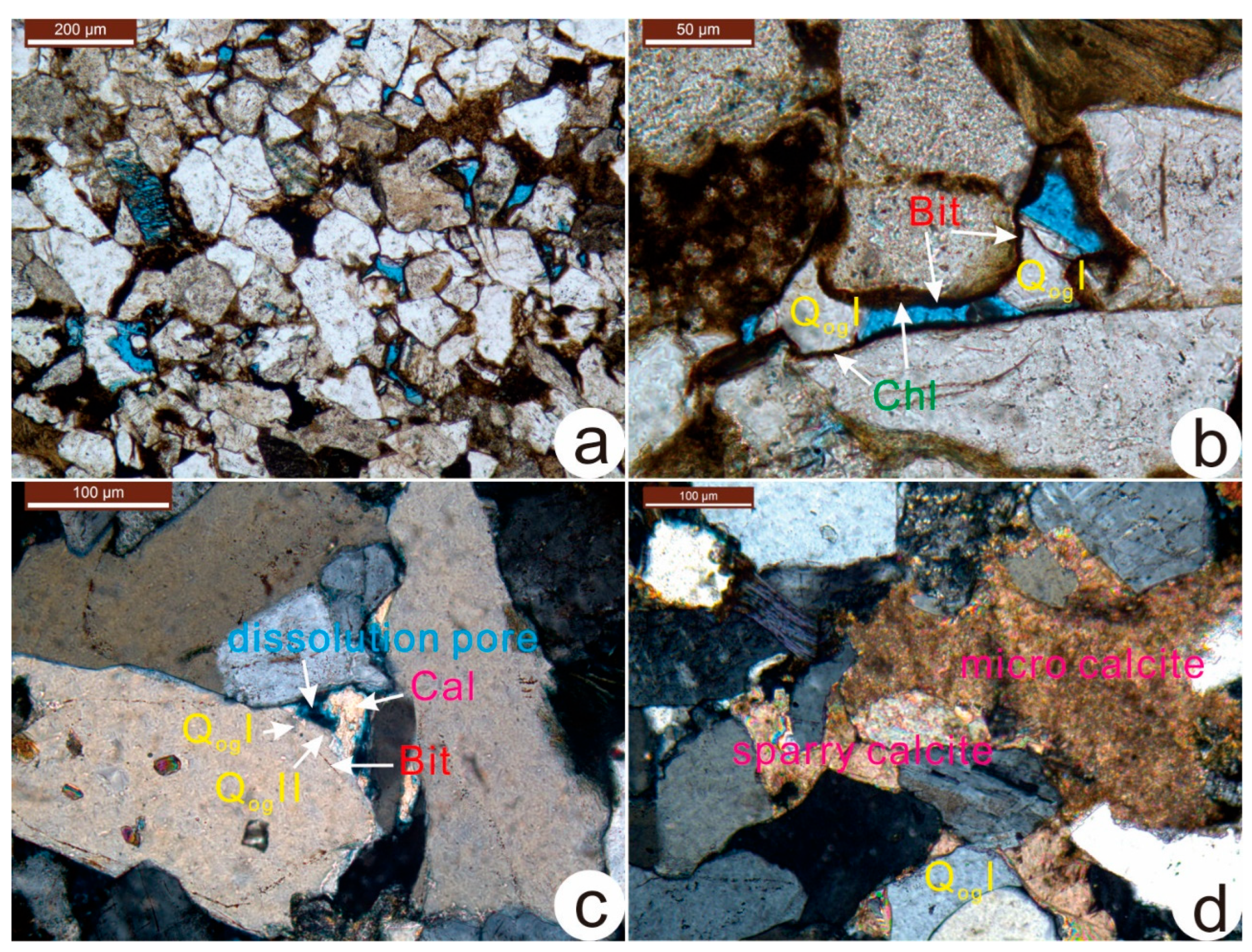
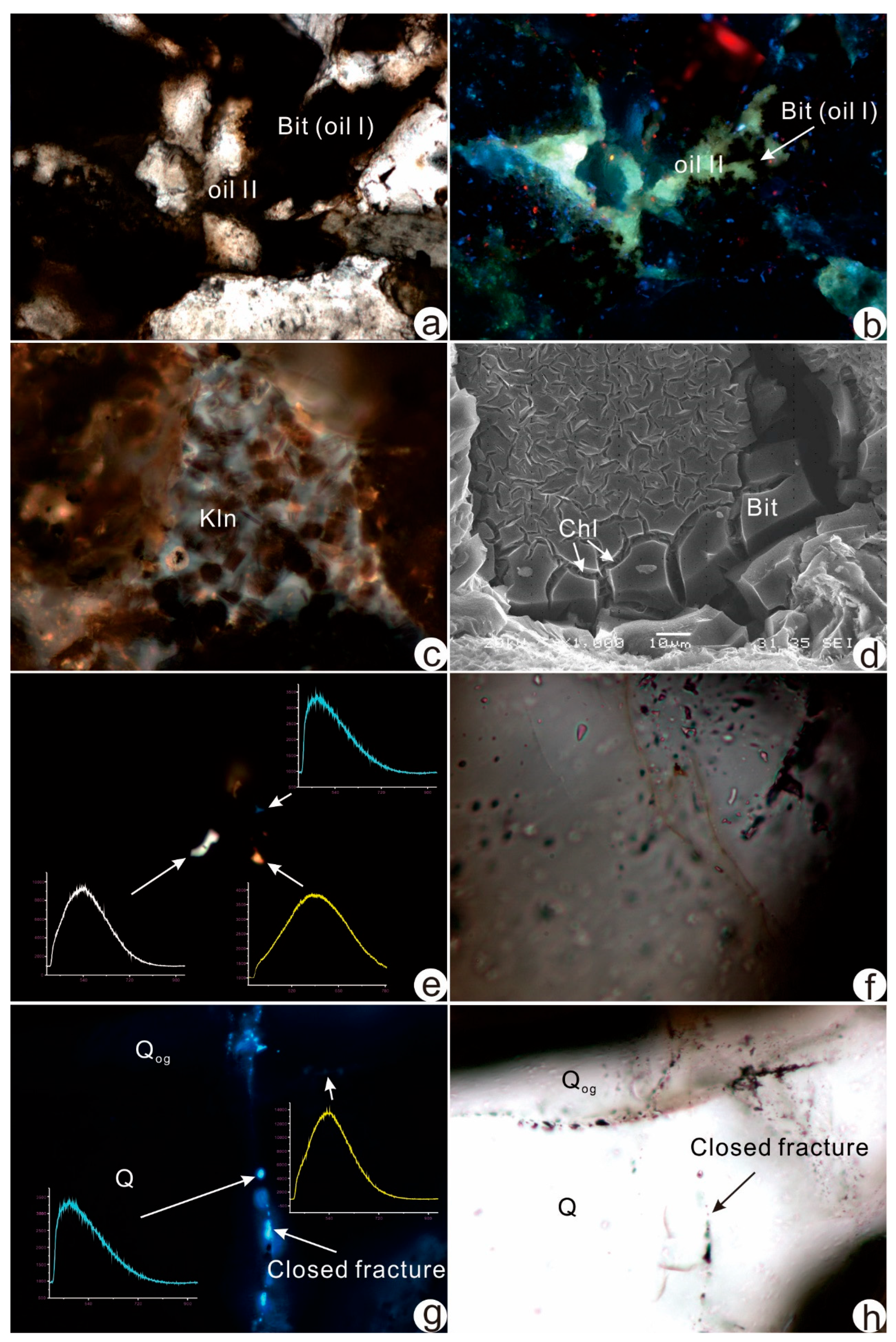
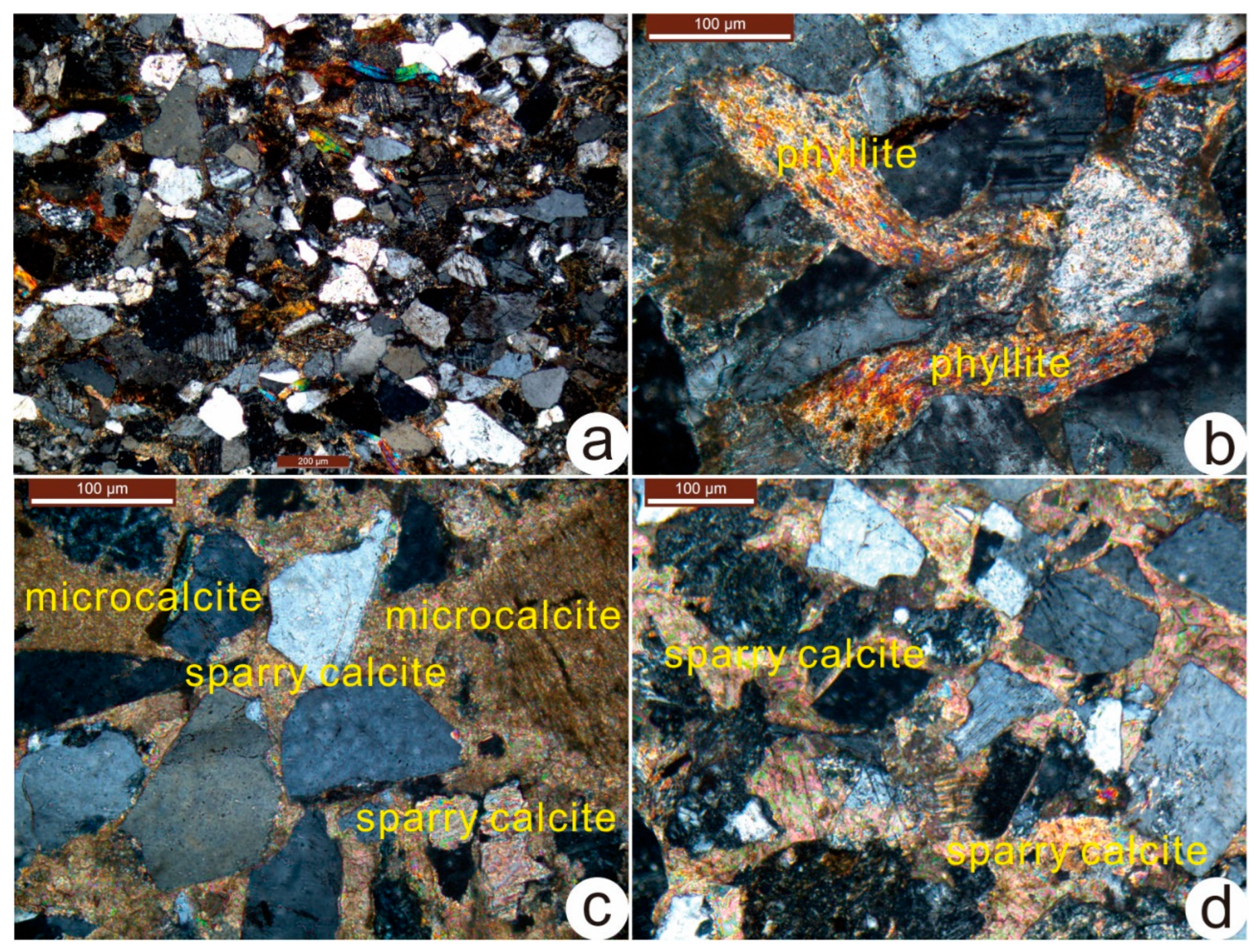

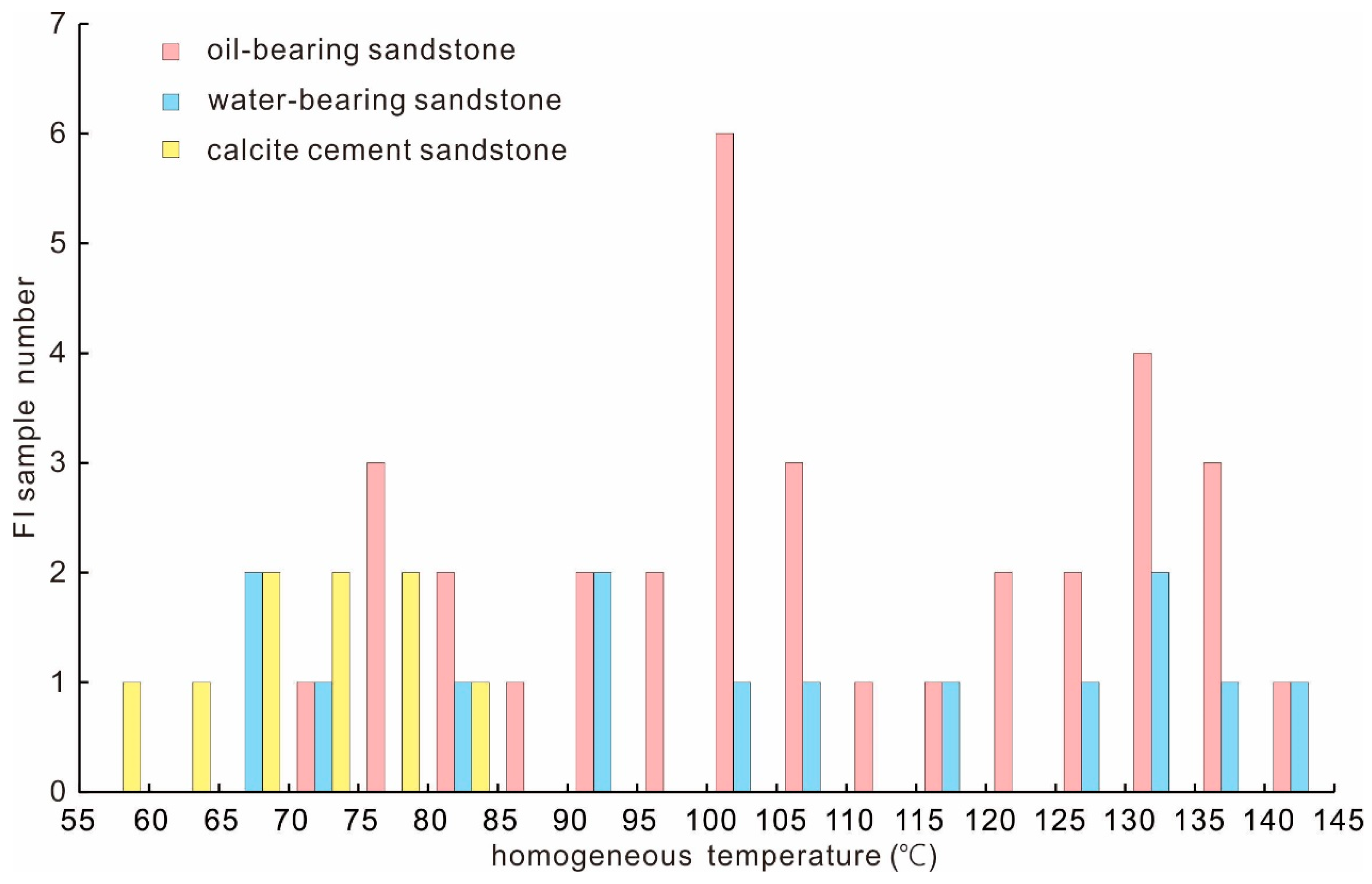
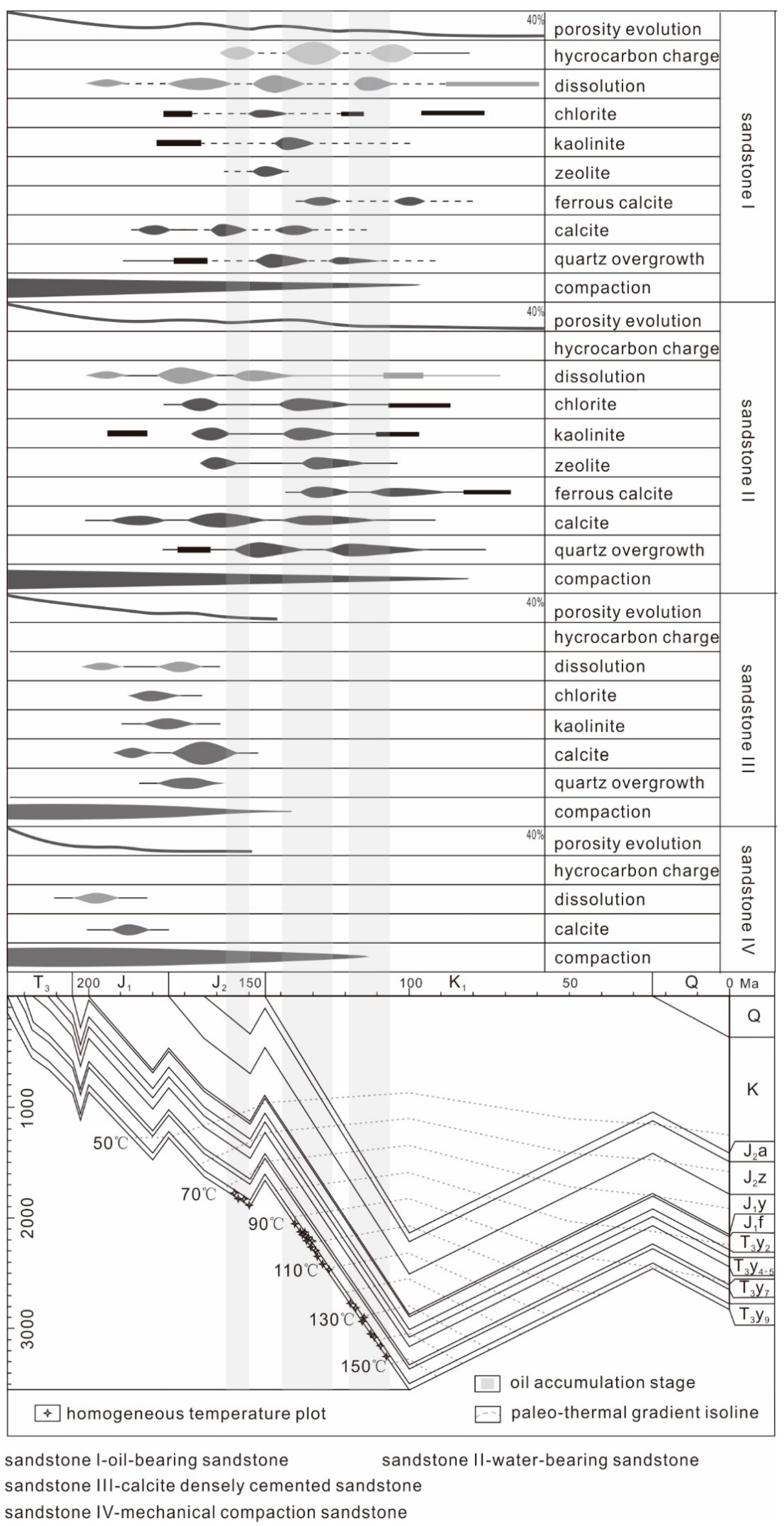
| Sandstone Types | Value | Q/% | F/% | Rl/% | Dl/% | C/% | Pp/% | IGV/% | |
|---|---|---|---|---|---|---|---|---|---|
| Oil-bearing sandstone | maximum | 46.1 | 39.9 | 19.7 | 19.9 | 23.0 | 9.7 | 28.3 | |
| minimum | 25.0 | 21.4 | 6.1 | 3.5 | 1.0 | 1.4 | 11.8 | ||
| mean | 31.1 | 30.2 | 11.9 | 8.3 | 8.8 | 4.5 | 18.1 | ||
| Water-bearing sandstone | maximum | 36.0 | 42.9 | 18.5 | 15.7 | 26.0 | 7.4 | 29.8 | |
| minimum | 21.8 | 27.4 | 4.0 | 2.1 | 0.0 | 0.5 | 7.6 | ||
| mean | 30.6 | 33.6 | 10.8 | 8.3 | 10.4 | 3.2 | 16.4 | ||
| Non-permeable sandstone | I | maximum | 35.0 | 45.0 | 11.1 | 24.3 | 12.0 | 1.5 | 25.2 |
| minimum | 20.0 | 18.7 | 4.2 | 7.2 | 0.0 | 0.0 | 10.0 | ||
| mean | 29.3 | 31.3 | 8.3 | 16.1 | 6.8 | 0.4 | 14.6 | ||
| II | maximum | 31.7 | 29.6 | 17.2 | 14.2 | 35.0 | 1.5 | 35.0 | |
| minimum | 18.2 | 18.9 | 6.2 | 3.4 | 20.0 | 0.0 | 21.3 | ||
| mean | 25.7 | 25.2 | 11.4 | 8.7 | 26.8 | 0.3 | 28.7 | ||
| Well | Depth (m) | Sandstone Types | Host Cement Mineral | Homogeneous Temperature (°C) | Hydrocarbon Color During the Same Period |
|---|---|---|---|---|---|
| Y190 | 1843.26 | Oil-bearing sandstone | Qog | 105.2 | Light yellow |
| Qog | 87.6 | Yellow brown | |||
| Qog | 102.5 | Light yellow | |||
| Qog | 142.7 | blue | |||
| Cal | 98.5 | Yellow brown | |||
| Fe-Cal | 104.9 | Light yellow | |||
| Fe-Cal | 132.6 | blue | |||
| Z500 | 1865.17 | Oil-bearing sandstone | Qog | 102.5 | Yellow green |
| Qog | 101.6 | Light yellow | |||
| Qog | 93.3 | Yellow brown | |||
| Qog | 90.7 | Yellow brown | |||
| ZC47 | 2227.7 | Oil-bearing sandstone | Qog | 123.9 | blue |
| Cal | 97.2 | Yellow brown | |||
| Fe-Cal | 110.1 | Light yellow | |||
| Fe-Cal | 126.3 | blue | |||
| SMC | 135 | blue | |||
| DT1738 | 2234.16 | Oil-bearing sandstone | Fe-Cal | 125.9 | blue |
| SMC | 116.7 | Light yellow | |||
| SMC | 138.2 | blue | |||
| Z542 | 1894.37 | Oil-bearing sandstone | SMC | 136.8 | blue |
| DZ3251 | 2672.2 | Oil bearing sandstone | SMC | 83.6 | Yellow brown |
| Qog | 78.8 | Yellow brown | |||
| Qog | 75.1 | Yellow brown | |||
| Qog | 81.7 | Yellow brown | |||
| DZ3251 | 2676.5 | Oil-bearing sandstone | Qog | 101.1 | Yellow green |
| Qog | 103 | Light yellow | |||
| 4089 | 2222.9 | Oil-bearing sandstone | Qog | 108.4 | Light yellow |
| Qog | 121.5 | blue | |||
| Qog | 131 | blue | |||
| Cal | 107.3 | Yellow green | |||
| Cal | 77.1 | Yellow brown | |||
| SMC | 131.9 | blue | |||
| JT322 | 2087.71 | Water-bearing sandstone | Qog | 67.9 | None HFI |
| Qog | 103.7 | None HFI | |||
| Cal | 92.7 | None HFI | |||
| Fe-Cal | 143.4 | None HFI | |||
| W80 | 2281.9 | Water-bearing sandstone | Qog | 74.9 | None HFI |
| Cal | 66.1 | None HFI | |||
| Cal | 105.4 | None HFI | |||
| Fe-Cal | 130.2 | None HFI | |||
| SMC | 139.7 | None HFI | |||
| JT648 | 1967.34 | Water-bearing sandstone | Qog | 127.5 | None HFI |
| Fe-Cal | 90.4 | None HFI | |||
| SMC | 132.5 | None HFI | |||
| JT322 | 1947.28 | Water-bearing sandstone | Fe-Cal | 117.6 | None HFI |
| ST24 | 2124.5 | Calcite-cemented sandstone | Qog | 73.2 | None HFI |
| Cal | 76.7 | None HFI | |||
| DT6529 | 2114.87 | Calcite-cemented sandstone | Cal | 74.3 | None HFI |
| Cal | 64.1 | None HFI | |||
| Cal | 78.3 | None HFI | |||
| D13 | 2691.24 | Calcite-cemented sandstone | Cal | 56.3 | None HFI |
| ZC94 | 2182.28 | Calcite-cemented sandstone | Qog | 84.6 | None HFI |
| Qog | 68.4 | None HFI | |||
| Cal | 68.5 | None HFI |
Disclaimer/Publisher’s Note: The statements, opinions and data contained in all publications are solely those of the individual author(s) and contributor(s) and not of MDPI and/or the editor(s). MDPI and/or the editor(s) disclaim responsibility for any injury to people or property resulting from any ideas, methods, instructions or products referred to in the content. |
© 2025 by the authors. Licensee MDPI, Basel, Switzerland. This article is an open access article distributed under the terms and conditions of the Creative Commons Attribution (CC BY) license (https://creativecommons.org/licenses/by/4.0/).
Share and Cite
Hu, C.; Zhang, L.; Lei, Y.; Yu, L.; Qin, J.; Zhang, X. Differential Diagenesis and Hydrocarbon Charge of the Tight-Sandstone Reservoir: A Case Study from Low-Permeable Sandstone Reservoirs in the Ninth Member of the Upper Triassic Yanchang Formation, Ordos Basin, China. Minerals 2025, 15, 544. https://doi.org/10.3390/min15050544
Hu C, Zhang L, Lei Y, Yu L, Qin J, Zhang X. Differential Diagenesis and Hydrocarbon Charge of the Tight-Sandstone Reservoir: A Case Study from Low-Permeable Sandstone Reservoirs in the Ninth Member of the Upper Triassic Yanchang Formation, Ordos Basin, China. Minerals. 2025; 15(5):544. https://doi.org/10.3390/min15050544
Chicago/Turabian StyleHu, Caizhi, Likuan Zhang, Yuhong Lei, Lan Yu, Jing Qin, and Xiaotao Zhang. 2025. "Differential Diagenesis and Hydrocarbon Charge of the Tight-Sandstone Reservoir: A Case Study from Low-Permeable Sandstone Reservoirs in the Ninth Member of the Upper Triassic Yanchang Formation, Ordos Basin, China" Minerals 15, no. 5: 544. https://doi.org/10.3390/min15050544
APA StyleHu, C., Zhang, L., Lei, Y., Yu, L., Qin, J., & Zhang, X. (2025). Differential Diagenesis and Hydrocarbon Charge of the Tight-Sandstone Reservoir: A Case Study from Low-Permeable Sandstone Reservoirs in the Ninth Member of the Upper Triassic Yanchang Formation, Ordos Basin, China. Minerals, 15(5), 544. https://doi.org/10.3390/min15050544





